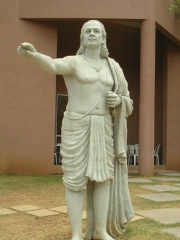


The Most Famous
ASTRONOMERS from India
This page contains a list of the greatest Indian Astronomers. The pantheon dataset contains 644 Astronomers, 3 of which were born in India. This makes India the birth place of the 28th most number of Astronomers behind Slovakia, and Egypt.
Top 3
The following people are considered by Pantheon to be the most legendary Indian Astronomers of all time. This list of famous Indian Astronomers is sorted by HPI (Historical Popularity Index), a metric that aggregates information on a biography's online popularity.

1. Aryabhata (476 - 550)
With an HPI of 75.26, Aryabhata is the most famous Indian Astronomer. His biography has been translated into 91 different languages on wikipedia.
Aryabhata ( ISO: Āryabhaṭa) or Aryabhata I (476–550 CE) was the first of the major mathematician-astronomers from the classical age of Indian mathematics and Indian astronomy. His works include the Āryabhaṭīya (which mentions that in 3600 Kali Yuga, 499 CE, he was 23 years old) and the Arya-siddhanta. For his explicit mention of the relativity of motion, he also qualifies as a major early physicist.

2. Varāhamihira (505 - 587)
With an HPI of 68.85, Varāhamihira is the 2nd most famous Indian Astronomer. His biography has been translated into 41 different languages.
Varāhamihira (c. 20/21 March 505 – c. 587), also called Varāha or Mihira, was an ancient Indian astrologer-astronomer who lived in or around Ujjain in present-day Madhya Pradesh, India.

3. Philip Herbert Cowell (1870 - 1949)
With an HPI of 51.37, Philip Herbert Cowell is the 3rd most famous Indian Astronomer. His biography has been translated into 17 different languages.
Philip Herbert Cowell FRS (1870 – 1949) was a British astronomer. Philip Herbert Cowell was born in Calcutta, India on the 7 August 1870, and educated at Eton and Trinity College, Cambridge. He became second chief assistant at the Royal Greenwich Observatory in 1896 and later became the Superintendent of HM Nautical Almanac Office between 1910 and 1930. He worked on celestial mechanics, and orbits of comets and minor planets in particular. He also carefully studied the discrepancy that then existed between the theory and observation of the position of the Moon. Cowell was elected a Fellow of the Royal Astronomical Society on 14 February 1896. On 27 October 1897 he was elected a member of the British Astronomical Association. He was also elected a Fellow of the Royal Society on 3 May 1906. In 1911 he won the Gold Medal of the Royal Astronomical Society. In 1909, he discovered 4358 Lynn, a 10-kilometer sized main-belt asteroid and member of the Eunomia. In 1910, for their work on Halley’s Comet Cowell and Andrew Crommelin jointly received the Prix Jules Janssen, the highest award of the Société astronomique de France, the French astronomical society and the Lindemann Prize of the Astronomische Gesellschaft. He died in Aldeburgh, Suffolk on 6 June 1949. The main-belt asteroid 1898 Cowell is named after him.
People
Pantheon has 3 people classified as Indian astronomers born between 476 and 1870. Of these 3, none of them are still alive today. The most famous deceased Indian astronomers include Aryabhata, Varāhamihira, and Philip Herbert Cowell.
Deceased Indian Astronomers
Go to all RankingsAryabhata
476 - 550
HPI: 75.26
Varāhamihira
505 - 587
HPI: 68.85
Philip Herbert Cowell
1870 - 1949
HPI: 51.37

